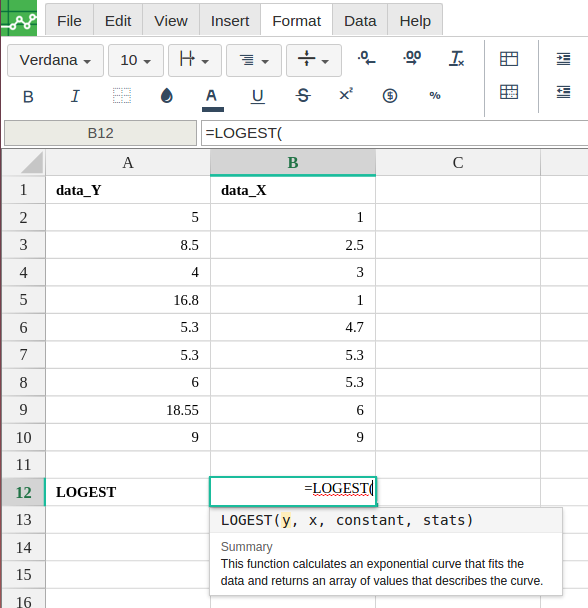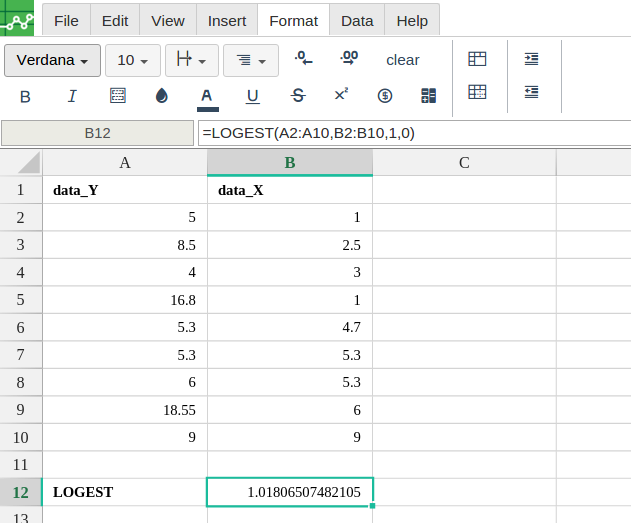LOGEST
Definition
Given partial data about an exponential growth curve, calculates various parameters about the best fit ideal exponential growth curve.
Sample Usage
Syntax
LOGEST(known_data_y, [known_data_x], [b], [verbose])
known_data_y- The array or range containing dependent (y) values that are already known, used to curve fit an ideal exponential growth curve.If
known_data_yis a two-dimensional array or range,known_data_xmust have the same dimensions or be omitted.If
known_data_yis a one-dimensional array or range,known_data_xmay represent multiple independent variables in a two-dimensional array or range. I.e. ifknown_data_yis a single row, each row inknown_data_xis interpreted as a separated independent value, and analogously ifknown_data_yis a single column.
known_data_x- [ OPTIONAL -{1,2,3,...}with same length asknown_data_yby default ] - The values of the independent variable(s) corresponding withknown_data_y.- If
known_data_yis a one-dimensional array or range,known_data_xmay represent multiple independent variables in a two-dimensional array or range. I.e. ifknown_data_yis a single row, each row inknown_data_xis interpreted as a separated independent value, and analogously ifknown_data_yis a single column.
- If
b- [ OPTIONAL -TRUEby default ] - Given a general exponential form ofy = b*m^xfor a curve fit, calculatesbifTRUEor forcesbto be1and only calculates themvalues ifFALSE.verbose- [ OPTIONAL -FALSEby default ] - A flag specifying whether to return additional regression statistics or only the calculated coefficient and exponents.If
verboseisTRUE, in addition to the set of exponents for each independent variable and the coefficientb,LOGESTreturnsThe standard error for each exponent and the coefficient,
The coefficient of determination (between 0 and 1, where 1 indicates perfect correlation),
Standard error for the dependent variable values,
The F statistic, or F-observed value indicating whether the observed relationship between dependent and independent variables is random rather than exponential,
The degrees of freedom, useful in looking up F statistic values in a reference table to estimate a confidence level,
The regression sum of squares, and
The residual sum of squares.
Notes
- The statistics calculated by
LOGESTare similar toLINESTbut use the linear modelln y = x1 ln m1 + ... + xn ln mn + ln bfor each independent variablex1 ... xn. Therefore additional statistics such as the standard error must be compared to the natural logarithms of themandbvalues rather than the values themselves.
See Also
TREND: Given partial data about a linear trend, fits an ideal linear trend using the least squares method and/or predicts further values.
LINEST: Given partial data about a linear trend, calculates various parameters about the ideal linear trend using the least-squares method.
GROWTH: Given partial data about an exponential growth trend, fits an ideal exponential growth trend and/or predicts further values.
In order to use the LOGEST formula, start with your edited Excellentable:


A
|
B
|
|
|---|---|---|
1
|
||
2
|
||
3
|
||
4
|
||
5
|
||
6
|
||
7
|
||
8
|
||
9
|
||
10
|
||
11
|
||
12
|
